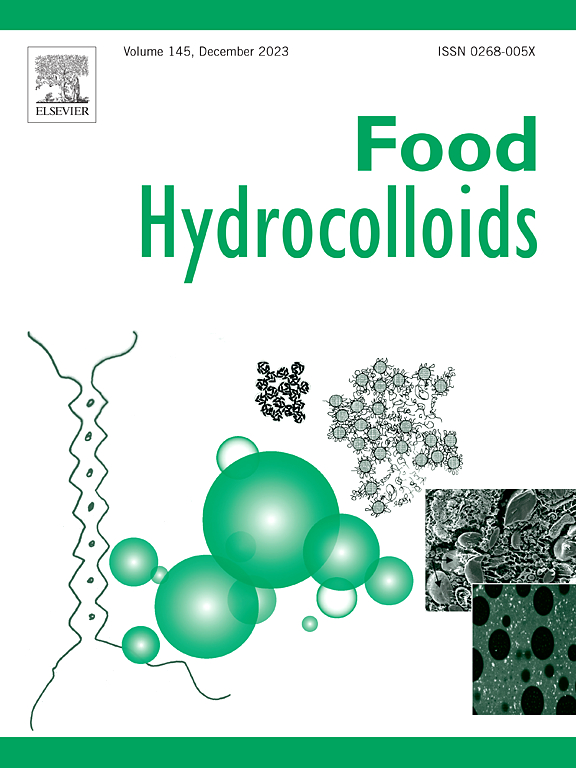IF 11
1区 农林科学
Q1 CHEMISTRY, APPLIED
引用次数: 0
摘要
本研究阐明了精氨酸(Arg+)抑制谷蛋白聚集和提高溶解度的机制,重点是利用一组高分子量谷蛋白缺失系研究单个高分子量谷蛋白亚基(HMW-GS)。Arg+ 、胍(Gdn+)和甘氨酸(Gly)的比较分析表明,与野生型相比,HMW-GS 基因缺失株的溶解度增加了,尤其是在 Arg+ 和 Gdn+ 的情况下:Bx7;By8;Ax1;Dy12;Dx2。Arg + 通过淬灭谷蛋白结构来提高溶解度,主要是重组氢键、削弱疏水相互作用、破坏 β 片层的稳定性、促进 β 转折和 β 片层转换,以及从 ggg 转变为最不稳定的二硫键构象 (tgt)。分子动力学模拟显示,在胍基介导的相互作用和局部拥挤效应的驱动下,Dx2 对 Arg+ 的敏感性增强。这些发现凸显了胍基在提高溶解度方面的主导作用,而羧基和烷基则起辅助作用。本文章由计算机程序翻译,如有差异,请以英文原文为准。

Mechanistic insights into arginine-mediated gluten solubility enhancement and aggregation inhibition across specific subunit and molecular scales
This study elucidates the mechanisms by which arginine (Arg+) inhibits gluten aggregation and enhances solubility, focusing on individual high-molecular-weight glutenin subunit (HMW-GS) using a set of HMW-GS deletion lines. Comparative analyses with Arg+, guanidine (Gdn+), and glycine (Gly) demonstrated increased solubility in HMW-GS deletion lines compared to wild type, particularly under Arg+ and Gdn+, following the order for HMW-GS deletion at: Bx7 > By8 > Ax1 > Dy12 > Dx2. Arg + enhanced solubility by quenching gluten structure, primarily restructuring hydrogen bonds, weakening hydrophobic interactions, destabilizing β-sheets, and facilitating β-turn and β-sheet transitions, alongside shifts from ggg to the least stable disulfide bond conformation (tgt). Molecular dynamics simulations revealed the heightened sensitivity of Dx2 to Arg+, driven by guanidino-mediated interactions and local crowding effects. These findings highlight the dominant role of the guanidino group in solubility enhancement, with carboxyl and alkyl groups playing supporting roles.
求助全文
通过发布文献求助,成功后即可免费获取论文全文。
去求助
来源期刊

Food Hydrocolloids
工程技术-食品科技
CiteScore
19.90
自引率
14.00%
发文量
871
审稿时长
37 days
期刊介绍:
Food Hydrocolloids publishes original and innovative research focused on the characterization, functional properties, and applications of hydrocolloid materials used in food products. These hydrocolloids, defined as polysaccharides and proteins of commercial importance, are added to control aspects such as texture, stability, rheology, and sensory properties. The research's primary emphasis should be on the hydrocolloids themselves, with thorough descriptions of their source, nature, and physicochemical characteristics. Manuscripts are expected to clearly outline specific aims and objectives, include a fundamental discussion of research findings at the molecular level, and address the significance of the results. Studies on hydrocolloids in complex formulations should concentrate on their overall properties and mechanisms of action, while simple formulation development studies may not be considered for publication.
The main areas of interest are:
-Chemical and physicochemical characterisation
Thermal properties including glass transitions and conformational changes-
Rheological properties including viscosity, viscoelastic properties and gelation behaviour-
The influence on organoleptic properties-
Interfacial properties including stabilisation of dispersions, emulsions and foams-
Film forming properties with application to edible films and active packaging-
Encapsulation and controlled release of active compounds-
The influence on health including their role as dietary fibre-
Manipulation of hydrocolloid structure and functionality through chemical, biochemical and physical processes-
New hydrocolloids and hydrocolloid sources of commercial potential.
The Journal also publishes Review articles that provide an overview of the latest developments in topics of specific interest to researchers in this field of activity.
 求助内容:
求助内容: 应助结果提醒方式:
应助结果提醒方式:


